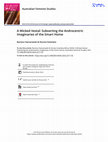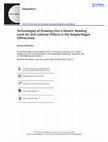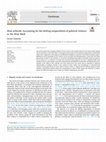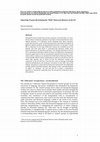Books by Dorota Golanska

Routledge, 2023
The book presents a new materialist understanding of acts of deliberate destruction of the built ... more The book presents a new materialist understanding of acts of deliberate destruction of the built environment and, specifcally, of the politics of aggressive spatial containment and regularization of urbanity employed within the confict in Israel/Palestine. Building on recent scholarship on slow violence and urbicidal policies, it discusses the different dimensions of the violence against the urban space, as well as exposes the complex materialsemiotic character of the urban territory and of its destruction. By referring to the concepts of "ethno-territoriality" and "the right to the city," the book aims to generate an enhanced understanding of problems situated at the overlap of urban studies and investigations of state-sponsored violence, focusing specifcally on issues related to urban warfare. Adopting a new materialist perspective, the book is a searing examination of political violence in our times. The volume will be of great interest to scholars and researchers of political science, international relations, cultural studies, and urban studies. It will also appeal to NGO professionals and activists across the world.

Rowman&Littlefield Int., 2017
Inspired by the philosophical framework of Deleuze and Guattari in relation to affect, Affective ... more Inspired by the philosophical framework of Deleuze and Guattari in relation to affect, Affective Connections disavows the dominant oppositional discourse around representation to offer an affirmative approach to perception, cognition and experience. It advances a new materialist concept of synaesthetic perception, where synaesthesia is understood as a union of senses. This idea offers a new figuration for thinking about our cognition, exploring the role of embodied experience and the agency of matter in the production of knowledge.
Looking at a number of memorials, memory sites and artworks relating to the Holocaust the book uses this idea of synaesthetic perception to explore trauma, memory and the production of art in relation to painful memories. In doing so, it demonstrates that modes of interacting with the past and encountering the lived experience of trauma can trigger a deeper understanding of these events and produce more complex forms of affective connections. It proposes a shift away from empathy towards sympathy (understood in new materialist terms), not just as a sentimental response to trauma but as an affective notion that allows for a more comprehensive grasp of experiences of discrimination, exclusion, suffering, or pain.
Edited Books by Dorota Golanska

Routledge, May 2022
This volume explores the processes of investigating cultures of equality and sets out an epistemo... more This volume explores the processes of investigating cultures of equality and sets out an epistemological framework for generating a more just and response-able knowledge. It offers a tapestry of inventive, self-reflexive, collective, and situated praxis of conducting politically informed research. Such efforts contest—or occasionally reinvent—the social and cultural worlds that we currently inhabit, in an attempt at building cultures of equality across different locations and contexts. The book engages with the idea of producing knowledge with others, indicating the political potential of scientific practice and offering a view of knowledge as a collective affective-intellectual effort. It provides an inventory of creative engagements with concepts and methodologies enabling production of socially responsible knowledges. By critically exploring new possibilities of scientific inquiry, the contributors reflect on how knowledge can be generated to serve the political agenda of movements for equality and social justice. The chapters also elucidate different conceptualisations of and approaches to who the researcher is and how they interact with cultural and social worlds.
https://www.routledge.com/Investigating-Cultures-of-Equality/Golanska-Rozalska-Clisby/p/book/9781032105161
Lodz University Press, 2012
Routledge, 2011
This collection responds to the need to re-evaluate the very important concept of citizenship in ... more This collection responds to the need to re-evaluate the very important concept of citizenship in light of recent feminist debates. In contrast to the dominant universalizing concepts of citizenship, the volume argues that citizenship should be theorized on many different levels and in reference to diverse public and private contexts and experiences. The book seeks to demonstrate that the concept of citizenship needs to be understood from a gendered intersectional perspective and argues that, though it is often constructed in a universal way, it is not possible to interpret and indeed understand citizenship without situating it within a specific political, legal, cultural, social, and historical context.
Lodz University Press, 2011

Zuidam Uithof Drukkerijen, Utrecht, 2009
Visual literacy is crucial for understanding the role of visual culture as a key factor in proces... more Visual literacy is crucial for understanding the role of visual culture as a key factor in processes of globalization, technologization and multiculturalization, which are all part of our historicity. Certainly, the study of the visual is not limited to the study of images, but also of their effects, material practices they entail and creative potential they offer. Therefore, it is of critical importance to work out new approaches to study both epistemologies and ontologies of the visual. Teaching Visual Culture in an Interdisciplinary Classroom weaves together various critical paradigms, theories and methodologies within the common field of feminist visual culture. By doing so, it demonstrates the importance of the analysis of the visual for feminist studies as well as the need to increase visual literacy in general. The volume provides theoretical and methodological support and examples of possible analyses for researchers and students interested in the field of feminist visual culture or, more generally, women’s studies, gender studies, visual studies, art studies and science studies. It presents feminist theories and methodologies, which were influential for the field of visual culture and encourages readers to think critically about the visual.
Lodz University Press, 2008
Papers by Dorota Golanska

A Wicked Vestal: Subverting the Androcentric Imaginaries of the Smart Home, 2024
Drawing on feminist technology studies’ interventions in current research on smart homes, this ar... more Drawing on feminist technology studies’ interventions in current research on smart homes, this article offers an analysis of recent cultural artifacts that – in contrast to the predominant marketized narratives infused with androcentricity and biased toward a reaffirmation of stereotypical gender roles – dislocate the conventional power relations within the technologized domestic space. The article elaborates an original concept of a ‘wicked vestal’, which may serve as a heuristic tool to capture the revisionist dynamics operating within (and partly enabled by) the technology-imbued home. The article argues, that creative subversions of the mainstream discourse on smartification offered by literary/artistic/cinematic products may add nuance to the existent discussions on smart technologies, offering a glimpse into the processes of a (dis)harmonious integration of technology and domesticity, alerting consumers of smart devices to, and possibly readying them for, the precariousness lurking in an unpredictable, capitalism-ridden techno-future.

Memory Studies, 2023
This essay explores the difficulties faced by the field of memory studies to adequately address u... more This essay explores the difficulties faced by the field of memory studies to adequately address unspectacular violence. While a majority of mnemonic strategies focus on events of spectacular disasters, outrageous atrocities, extreme occurrences, and massive sufferings contained in time and space, the damages generated by unspectacular operations of slow, latent, and silent violence remain difficult to recognize within the memorial landscape. Building on the concept of slow violence, as well as on posthumanist approaches to violent legacies of colonialism, and in the context of the current shift within memory studies toward a planetary sensitivity, this essay interrogates the possibilities of doing justice to the invisibilized harm spreading across long periods of time in different parts of the world. Sketching a possible agenda for the future, the essay suggests that a critical engagement with theorizations of feminist geopoliticians, along with a turn to practices of minor remembrance, can enable a more effective linking of the unspectacular to the spectacular, ensuring the visibility of the former amid memorializing practices.

Text Matters: A Journal of Literature, Theory, and Culture, 2023
Bringing together insights originating in law studies and art analysis, this article approaches t... more Bringing together insights originating in law studies and art analysis, this article approaches the work of the US-based Syrian artist Lara Haddad through the figuration of "interior frontiers," exposing how both "interior bonds" and "internal borders" tended to shape legal regulations introduced in the US in the aftermath of 9/11 for the purpose of conducting "the global war on terror." Referring to the concept of "plasticity," the article examines the intimate (dis)identifications experienced by the artist in the context of the politically saturated cultural discourses on violence which emerged from the post-9/11 spatialities of (inter)national law. The article argues that politically engaged art offers a means to affectively connect with the personal ways of coping with the persistent visceral presence of structural violence, shedding light on how political protocols and cultural representations impinge upon the individual experiences of many Muslims residing inside and outside the US territory. Opening established meanings to new interpretations, such art contributes to the process of revising dominant oppressive significations, creating room for critical contestation and increased transcultural understanding.

Geography Compass, 2023
Engaging with recent applications of the concept of slow violence to the ongoing political develo... more Engaging with recent applications of the concept of slow violence to the ongoing political developments in the West Bank, this review article argues that the relational approach offered by feminist geopolitics facilitates the conception of slow violence and warfare as part of a single complex of violence. The article traces feminist geopolitics' contribution to research on geographies of slow violence on the one hand, and to the analyses produced within the fields of critical geopolitics and critical war studies on the other, exposing that scholarly work exploiting the relational approach generated within and across these areas of research enables a broader understanding of political violence's tangled operations. Based on the analysis of the recent scholarly engagement with slow violence in the West Bank, the article proposes that thinking of slowness as a form of warfare captures the complex entanglement of different modalities of violence as they materialize in specific spatio-temporal circumstances. Moreover, such an approach contributes to the further reinvigoration of feminist geopolitics with insights generated within (settler) colonial studies.

cultural geographies, 2023
This article engages with the material geographies of colonialism in Israel/Palestine by looking ... more This article engages with the material geographies of colonialism in Israel/Palestine by looking at the site-specific cultural activities in Iqrit (Israel), a Christian-Arab village depopulated during the 1948 war in the region. We investigate the importance of material infrastructure-and material, bodily encounters with the site-as a basis for the place-based activist memory-work, as well as exposing the ways in which such activities contribute to the advancement of 'the politics of presence', understood as a manifestation of a continuous resilience vis-à-vis the discriminatory policy of the state. Our argumentation focuses on the importance of physical presence in specific geographical areas, shedding light on how place-based activities may contravene the expressed state policy by increasing the fluidity of the territory, creating spaces of contestation in which the traditional understandings of state authority partly dissolve. It also explores how the material reconfigurations of the place, and emotional-bodily investment in it, contribute to the semantic instability of the site, turning the place-based memory-work into a future-oriented project with important political aspirations.

Geopolitics, 2023
Experimenting with a new materialist diffractive approach, this article offers an insight into th... more Experimenting with a new materialist diffractive approach, this article offers an insight into the agential capacities of lines by juxtaposing two apparently unrelated cases of large-scale drawing practices: the aesthetic process involved in an event of artistic creation and the scientific process of visual representation of data-supported meteorological measurements. The article makes use of the analysis of Jim Denevan’s land art as a tool with which to approach cartography-based colonial politics in the Naqab/Negev Desert (Israel). Such an unusual methodological strategy assists in exposing how political decisions based on the system of scientific classification of land have contributed to the substantial reconfiguration of settlement patterns in the region, negatively affecting the life of a significant number of Bedouin Arabs, indigenous to this land. By investigating the possibly harmful, highly politicised potentials of cartographic endeavours while uncovering their material-semiotic contingency, the article reveals how the enterprise of mapping space can benefit colonialism and discriminatory politics. The aim is to offer a cultural studies understanding of the problematic political and environmental developments taking place in the Naqab/Negev, explaining how the science-based politics of drawing has been mobilised for the purpose of colonial policy, translating into the discriminatory treatment of the indigenous population while extrapolating spatial injustices in the region.

Canadian Slavonic Papers, 2022
Employing concepts of traumatic memory, post-memory, and dirty memory, this article analyzes the ... more Employing concepts of traumatic memory, post-memory, and dirty memory, this article analyzes the narrative of Władysław Pasikowski’s Aftermath (2012) to shed light on broader processes of (non-)engagement with the traumatic, culturally mediated past connected with the tangled legacies of the Holocaust in Poland. Analysis of the film’s narrative and attention to its reception in Poland can help to diagnose the condition of collective memory of the Shoah prevailing in contemporary Polish society. Adopting a new materialist lens, the article complicates the issue of contested legacies of violence, considering also the perpetrators’ trauma inherited by representatives of the second generation, situating both in the context of the dominant mnemonic strategies circulating in Polish culture since the end of World War II. It argues that the same interpretative tropes still shape ways of negotiating legacies of violence, silencing undesired narratives of collaboration in and responsibility for crimes committed against Polish Jewry during World War II.
Free downloads available at: https://www.tandfonline.com/eprint/JGDPIAN5YEYMRSRHKJWC/full?target=10.1080/00085006.2022.2133953

Geoforum, 2022
The article explores the conceptual affinities of slow violence and urbicidal policies in the con... more The article explores the conceptual affinities of slow violence and urbicidal policies in the context of the ongoing Israeli colonization of the West Bank. It investigates the processes of the systematic degeneration of Palestinian urban tissue, triggered by state-supported intentional developments connected to the Israeli settlement project. Building on recent scholarship on slow violence, on the one hand, and urbicidal policies, on the other, the article proposes the concept of "slow urbicide" to account for the shifting temporalities of urbicidal violence as much as for its reliance on, or activation of, human and more-than-human agencies and forces. Engaging briefly with scholarly work on urban trauma connected to dispossessions and deliberate destructions, the analysis also draws attention to the effects of slow urbicide. On a more general level, the article aims to contribute to enhanced understanding of problems situated at the overlap of urban studies and investigations of state-sponsored violence, focusing specifically on issues related to urban warfare. It suggests that the different speeds at which urbicide is perpetuated should be taken into consideration in order to better capture the character of violence against the built environment and to expose its complex multitemporal operations.

RUUKKU: Studies in Artistic Research. Special Issue on Aesthetic Intra-Actions: Practising New Materialisms in the Art 9 https://www.researchcatalogue.net/view/427704/427706, 2018
Situated within a new materialist philosophical framework and inspired by its posthumanistic, pos... more Situated within a new materialist philosophical framework and inspired by its posthumanistic, postdualistic, and affirmative orientation, this article looks at instances of geo-art, understanding it in terms of intra-active knowledge production processes. It looks specifically at the artistic projects by Jim Denevan and by doing it, I aim to examine the concept of a non-academic artistic research with an aim of exposing that a detailed inspection of the processes involved in the artistic production sheds an altogether different light on the nature of all research practices and, as such, lets us engage more thoroughly with the “how-question” of generating knowledge, highlighting its processual material-semiotic character. As instantiated in my case studies, an inquiry of different relationalities involved in the process of artistic knowledge production enables a study of how subject and object emerge as a result of “intra-activity” (Barad 2007). Using his own body as both a tool and an active corporeal entity merging with the surrounding landscape, a geoartist Jim Denevan rhythmically and in a dance-like movement creates ephemeral gigantic drawings on sand, soil, or ice. They emerge out of a dynamic assemblage of the artist’s body and his tools and the local geophysical situation with different sorts of matter or forces present there. The natural environment operates as an agent actively engaged in the whole process of artistic creation—of both making and unmaking of the drawings. When finished by Denevan, his works of art remain dynamic; they are being gradually modified and eventually erased by the undulating waves, tides, gusts of wind, the working of erosion and weathering, until they completely disappear. Focusing on the engagement of the artist with the environment and the random audiences present on site, I want to make clear that such eco-sensitive creation may serve as an illuminating example of what forms the entanglements of art, research, and activism could take and what material-semiotic effects such creative activities produce for all actors (human and nonhuman) produce.

International Journal of Education Through Art, 2020
Situated within a new materialist paradigm, this article looks at instances of educational nature... more Situated within a new materialist paradigm, this article looks at instances of educational nature-creative artivism for sustainability. Connecting art and activism, artivism mobilizes creative means to embrace political or social intervention. Underlining the importance of practices, and employing the concept of creative practice, we point out that a detailed inspection of the processes involved in artistic production sheds a different light on the nature of all knowledge generating practices, letting us engage more thoroughly with the 'how-question' of producing knowledge. Focusing on two geoartistic/geopoetic educational initiatives, we argue that the eco-sensitive creation of artivists may serve as an example of what forms the entanglements of art and activism could take in the context of educational projects aimed at mobilizing thorough reflections of audiences. This may encourage the 1 The research discussed in the article has been carried out in accordance with the principles for research ethics of the University of Lodz in which one of the authors is affiliated as well as in line with the requirements of Sędzimir Foundation as far as involvement of human subjects is concerned. The workshops associated with this study served as case studies, wherein informed consent was obtained from the participants to take part in these initiatives. Participants also consented to having the events serve as examples in the research study. Additionally, the authors received consent from people appearing in the included photographs. This is an Authors' Original Manuscript of an article to be published in International Journal of Education Through Art (2020) [to quote, please consult the published version]

American Wild Zones. Space, Experience, Consciousness, ed. Jerzy Kamionkowski and Jacek Partyka, 51-57. New York and Frankfurt am Main: Peter Lang, 2016
Athough the logic of Holocaust memory operates crossculturally, it is nonetheless always contextu... more Athough the logic of Holocaust memory operates crossculturally, it is nonetheless always contextual, politicized, and often instrumentalized for national(ist) purposes. It is therefore worth analysing how these traumatic
events have become a part of national discourses and historical policies in
different cultural, political, and geographical locations. In my paper I would
like to elaborate on the ways Holocaust trauma has travelled across the
Atlantic and how (and why!) it contemporarily functions within more
general discourses on American memory. I am mostly interested in the diverse educational techniques (both narrative and affective) contemporary
museums apply with an aim of conveying the experience of trauma to their
visitors. Hence, taking as an example the United States Holocaust Museums, I will critically reflect on their organization as well as on the diverse ways in which they operate, also in terms of how the Holocaust trauma was „imported” to the US and how it has become a part of strategy of building national identifications and mnemonic narratives on the other side of the Atlantic. Drawing on a theoretical framework inspired from the philosophy of Gilles Deleuze and Félix Guattari, and resting on their conceptualization of „affect” or „intensity,” my aim will also be to foster a synaesthetic approach to memorials, especially from the perspective of functions these sites perform.
Historia i Polityka, 2020
Przyjmując perspektywę nowomaterialistyczną, artykuł poddaje analizie ekspozycję muzeum historycz... more Przyjmując perspektywę nowomaterialistyczną, artykuł poddaje analizie ekspozycję muzeum historycznego należącego do kompleksu Jad wa-Szem w Jerozolimie poświęconego upamiętnianiu Zagłady. Rozważania mają na celu ukazanie zastosowanych w muzeum subtelnych odwołań do konfliktu izraelsko-palestyńskiego. Argumentacja wskazuje w jaki sposób praktyki upamiętniania traumatycznych wydarzeń z przeszłości kształtowane są przez bieżące dyskursy i wyzwania polityczne, podkreślając związki między polityką historyczną a aktualnymi działaniami politycznymi.











Uploads
Books by Dorota Golanska
Looking at a number of memorials, memory sites and artworks relating to the Holocaust the book uses this idea of synaesthetic perception to explore trauma, memory and the production of art in relation to painful memories. In doing so, it demonstrates that modes of interacting with the past and encountering the lived experience of trauma can trigger a deeper understanding of these events and produce more complex forms of affective connections. It proposes a shift away from empathy towards sympathy (understood in new materialist terms), not just as a sentimental response to trauma but as an affective notion that allows for a more comprehensive grasp of experiences of discrimination, exclusion, suffering, or pain.
Edited Books by Dorota Golanska
https://www.routledge.com/Investigating-Cultures-of-Equality/Golanska-Rozalska-Clisby/p/book/9781032105161
Papers by Dorota Golanska
Free downloads available at: https://www.tandfonline.com/eprint/JGDPIAN5YEYMRSRHKJWC/full?target=10.1080/00085006.2022.2133953
events have become a part of national discourses and historical policies in
different cultural, political, and geographical locations. In my paper I would
like to elaborate on the ways Holocaust trauma has travelled across the
Atlantic and how (and why!) it contemporarily functions within more
general discourses on American memory. I am mostly interested in the diverse educational techniques (both narrative and affective) contemporary
museums apply with an aim of conveying the experience of trauma to their
visitors. Hence, taking as an example the United States Holocaust Museums, I will critically reflect on their organization as well as on the diverse ways in which they operate, also in terms of how the Holocaust trauma was „imported” to the US and how it has become a part of strategy of building national identifications and mnemonic narratives on the other side of the Atlantic. Drawing on a theoretical framework inspired from the philosophy of Gilles Deleuze and Félix Guattari, and resting on their conceptualization of „affect” or „intensity,” my aim will also be to foster a synaesthetic approach to memorials, especially from the perspective of functions these sites perform.
Looking at a number of memorials, memory sites and artworks relating to the Holocaust the book uses this idea of synaesthetic perception to explore trauma, memory and the production of art in relation to painful memories. In doing so, it demonstrates that modes of interacting with the past and encountering the lived experience of trauma can trigger a deeper understanding of these events and produce more complex forms of affective connections. It proposes a shift away from empathy towards sympathy (understood in new materialist terms), not just as a sentimental response to trauma but as an affective notion that allows for a more comprehensive grasp of experiences of discrimination, exclusion, suffering, or pain.
https://www.routledge.com/Investigating-Cultures-of-Equality/Golanska-Rozalska-Clisby/p/book/9781032105161
Free downloads available at: https://www.tandfonline.com/eprint/JGDPIAN5YEYMRSRHKJWC/full?target=10.1080/00085006.2022.2133953
events have become a part of national discourses and historical policies in
different cultural, political, and geographical locations. In my paper I would
like to elaborate on the ways Holocaust trauma has travelled across the
Atlantic and how (and why!) it contemporarily functions within more
general discourses on American memory. I am mostly interested in the diverse educational techniques (both narrative and affective) contemporary
museums apply with an aim of conveying the experience of trauma to their
visitors. Hence, taking as an example the United States Holocaust Museums, I will critically reflect on their organization as well as on the diverse ways in which they operate, also in terms of how the Holocaust trauma was „imported” to the US and how it has become a part of strategy of building national identifications and mnemonic narratives on the other side of the Atlantic. Drawing on a theoretical framework inspired from the philosophy of Gilles Deleuze and Félix Guattari, and resting on their conceptualization of „affect” or „intensity,” my aim will also be to foster a synaesthetic approach to memorials, especially from the perspective of functions these sites perform.
analytical perspective for approaching contemporary artistic memorials. The Memorial to the Murdered
Jews of Europe (designed by Eisenman, 2005) and The Garden of Exile (designed by Libeskind, 2001), both
situated in Berlin, serve as illustrative examples for theoretical investigations developed in this contribution.
Relying on Deleuze and Guattari’s definition of art, the article argues that these sites heighten our awareness
of materials, compositional structures, or the process of encountering the work. By weaving together the
representable (narrative/symbolic/semiotic) and the unrepresentable (traumatic/bodily/material), the sites
deny a purely representational logic, producing instead intensive singular events that are never fixed or
unwavering. The memorial character of these sites is therefore always emergent and contingent on the
complex dynamic material-semiotic assemblages of different bodies. As such, it only exists in the encounter.
Relation is its onto-epistemology.
Situated within the recent theoretical scholarship on memory and trauma in culture, the project aims at demonstrating that the new ways of interacting with the past as well as of encountering the lived experience of trauma made available by the contemporary artistic creation related to the Holocaust can produce a deeper understanding of these events and provoke a more complex form of empathy. Moreover, it argues, that empathy, which is not only a purely sentimental response, but rather itself constitutes a lived (affective) feeling, is extremely useful in didactic terms and, as such, allows for a more comprehensive grasp of experiences of discrimination or exclusion. The project aims at developing of a new theoretical perspective on Holocaust memorials (i.e., one grounded in radical empiricism that would allow to explore the concept of memory from bodily and materialist perspective) as well as of a novel approach to aesthetic experience (i.e., one relying on the mobilization of affect rather than on cognitive mental processes).